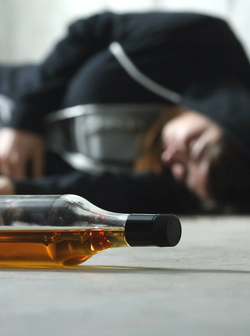An Occasional Party with Lots of Alcohol? Still Harmful, New Study Shows

A recent study outlines a key distinction regarding alcohol consumption, one not often discussed. It is the distinction of drinking patterns. Essentially, any pattern involving alcohol consumption, even if the pattern is infrequent but excessive consumption, is still a pattern that puts the user at risk for developing alcohol addiction.
It isn’t enough for public health institutions to issue guidelines on how much alcohol is OK on any given day or how often or seldom it’s considered “acceptable” to drink. Rather, Americans need to be informed that any pattern of drinking poses a risk for addiction, even if that pattern involves “just” drinking to excess a few times per year.
Research Indicates Harm in Occasional Binge Drinking
A group of researchers at the University of Texas at Austin found that, among Americans who typically drank at moderate levels, those who sometimes drank to excess were at an increased risk of developing alcohol-related problems. By ‘alcohol-related problems,’ the researchers listed several critical hardships, including:1
- Having irresistible urges to drink
- Needing to drink more to get the same effect
- Emotional, behavioral, or psychological symptoms related to alcohol
- Drinking even though doing so causes issues at work, school, or home
These are signs of alcohol addiction, suggesting that people who rarely drink to excess are still at significantly heightened risk of developing an alcohol addiction than those who do not drink alcohol. As for the hard data, the researchers found that people who said they’d binged in the past month were almost five times more likely to struggle with alcohol addiction than individuals who either did not drink at all or who drank in moderation but did not binge.
Furthermore, when the researchers followed up with study participants over nine years, the individuals who occasionally binged on alcohol were at least twice as likely to struggle with alcohol addiction than those who never binged.
The Importance of Understanding Drinking Patterns
Alcohol consumption guidelines have always focused on the amount of alcohol one consumes on a given day, not on patterns of consumption. The concept of “drinking in moderation” is said to be one drink in a day for women and two drinks for men.2

But the study’s authors and others who reviewed their research agree that the guidelines do not sufficiently emphasize the harm in going above the “moderate drinking” limit even once per year, and particularly when someone goes above that limit with any frequency. Quoting Katherine Keyes, a professor at Columbia University Mailman School of Public Health who reviewed the research, “The guidelines on moderate consumption are not sufficient. Under those guides, moderate drinking means averaging no more than one drink a day for women, and no more than two a day for men. But those are averages, and there is a difference between moderate drinkers who regularly have a glass of wine or beer with dinner and those who sometimes go on a binge.” Keyes pointed out that people in the latter group often get drunk, which can lead to addictive behavior and a compulsive need to experience drunkenness again.3
The crucial issue is that people who sometimes get drunk, even if they only do so a few times per year, are at risk for developing alcohol-related problems.
NIAAA Data Backs Up the Recent Study
The recent study’s findings are further confirmed by the National Institute on Alcohol Abuse and Alcoholism’s research into the harmful nature of excessive alcohol consumption. According to the NIAAA:4

- About 25% of Americans over 18 say they binge drink at least once per month, suggesting tens of millions of Americans are at risk for alcohol addiction.
- People who binge drink are at least 70 times more likely to have an alcohol-related emergency than those who drink in moderation.
- At least 14.5 million Americans struggle with alcohol addiction, meaning they drink excessively and cannot control their drinking.
- Fewer than 10% of those who struggle with alcohol addiction receive treatment.
- Three-quarters of the total monetary cost of alcohol-related harm in the U.S. ($249 billion per year) is related to binge drinking.
- Approximately 4.2 million young people between the ages of 12 and 20 engage in binge drinking (or about 11% of this age group). About 30% of young people ages 18 to 22 report binge drinking at least once per month.
The NIAAA reports that less alcohol consumption is always a better choice than more alcohol consumption, even if individuals keep their alcohol consumption within the “drinking within moderation” framework. Quoting NIAAA research, “Adults of legal drinking age can choose not to drink or to drink in moderation by limiting intake to 2 drinks or less in a day for men and 1 drink or less in a day for women, when alcohol is consumed. Drinking less is better for health than drinking more. Some individuals should avoid alcohol completely.” This recommendation should be the new standard, i.e., simply encouraging Americans to drink less.
Drinking to Excess Is Never OK
It may be time to consider updating the “drinking in moderation” guidelines to encourage Americans to consume no alcohol at all, rather than maintaining somewhat arbitrary guidelines that “some” alcohol is OK and safe. It seems that the one-drink-for-women and two-drinks-for-men guideline is too loose, as evidenced by the fact that people who follow those guidelines still fall prey to binge drinking and alcohol addiction. A safer choice would be not to drink at all.
Sources:
-
AJPM. “Binge Drinking and Alcohol Problems Among Moderate Average-Level Drinkers.” American Journal of Preventive Medicine, 2022. ajpmonline.org ↩︎
-
CDC. “Dietary Guidelines for Alcohol.” Centers for Disease Control and Prevention, 2022. cdc.gov ↩︎
-
USNews. “Weekend Binge Drinking: Not as Harmless as You Think.” USNews, 2022. usnews.com ↩︎
-
NIAAA. “Alcohol Facts and Statistics.” National Institute on Alcohol Abuse and Alcoholism, 2022. niaaa.nih.gov ↩︎





 ®
®